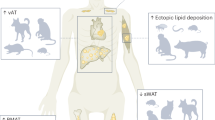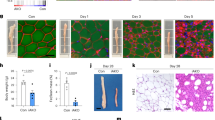Abstract
Objective:
Understanding the regulation of adipocyte differentiation by cellular and extracellular factors is crucial for better management of chronic conditions such as obesity, insulin resistance and lipodystrophy. Experimental infection of rats with a human adenovirus type 36 (Ad-36) improves insulin sensitivity and promotes adipogenesis, reminiscent of the effect of thiozolinediones. Therefore, we investigated the role of Ad-36 as a novel regulator of the adipogenic process.
Design and Results:
Even in the absence of adipogenic inducers, infection of 3T3-L1 preadipocytes and human adipose-derived stem cells (hASC) by Ad-36, but not Ad-2 that is another human adenovirus, modulated regulatory points that spanned the entire adipogenic cascade ranging from the upregulation of cAMP, phosphatidylinositol 3-kinase and p38 signaling pathways, downregulation of Wnt10b expression, and increased expression of CCAAT/enhancer binding protein-β and peroxisome proliferator-activated receptor γ2 and consequential lipid accumulation. Next, we identified that E4 open reading frame (orf)-1 gene of the virus is necessary and sufficient for Ad-36-induced adipogenesis. Selective knockdown of E4 orf-1 by RNAi abrogated Ad-36-induced adipogenic signaling cascade in 3T3-L1 cells and hASC. Compared to the null vector, selective expression of Ad-36 E4 orf-1 in 3T3-L1 induced adipogenesis, which was abrogated when the PDZ-binding domain of the protein was deleted.
Conclusion:
Thus, Ad-36 E4 orf-1 is a novel inducer of rodent and human adipocyte differentiation process.
This is a preview of subscription content, access via your institution
Access options
Subscribe to this journal
Receive 12 print issues and online access
$259.00 per year
only $21.58 per issue
Buy this article
- Purchase on Springer Link
- Instant access to full article PDF
Prices may be subject to local taxes which are calculated during checkout




Similar content being viewed by others
References
Rosen ED, Spiegelman BM . Adipocytes as regulators of energy balance and glucose homeostasis. Nature 2006; 444: 847–853.
Rosen ED, MacDougald OA . Adipocyte differentiation from the inside out. Nat Rev Mol Cell Biol 2006; 7: 885–896.
Yang X, Jansson PA, Nagaev I, Jack MM, Carvalho E, Sunnerhagen KS et al. Evidence of impaired adipogenesis in insulin resistance. Biochem Biophys Res Commun 2004; 317: 1045–1051.
Kim JK, Gavrilova O, Chen Y, Reitman ML, Shulman GI . Mechanism of insulin resistance in A-ZIP/F-1 fatless mice. J Biol Chem 2000; 275: 8456–8460.
Gavrilova O, Marcus-Samuels B, Graham D, Kim JK, Shulman GI, Castle AL et al. Surgical implantation of adipose tissue reverses diabetes in lipoatrophic mice. J Clin Invest 2000; 105: 271–278.
Pajvani UB, Trujillo ME, Combs TP, Iyengar P, Jelicks L, Roth KA et al. Fat apoptosis through targeted activation of caspase 8: a new mouse model of inducible and reversible lipoatrophy. Nat Med 2005; 11: 797–803.
Ranganathan G, Unal R, Pokrovskaya I, Yao-Borengasser A, Phanavanh B, Lecka-Czernik B et al. The lipogenic enzymes DGAT1, FAS, and LPL in adipose tissue: effects of obesity, insulin resistance, and TZD treatment. J Lipid Res 2006; 47: 2444–2450.
de Souza CJ, Eckhardt M, Gagen K, Dong M, Chen W, Laurent D et al. Effects of pioglitazone on adipose tissue remodeling within the setting of obesity and insulin resistance. Diabetes 2001; 50: 1863–1871.
Boden G, Cheung P, Mozzoli M, Fried SK . Effect of thiazolidinediones on glucose and fatty acid metabolism in patients with type 2 diabetes. Metabolism 2003; 52: 753–759.
Bogacka I, Xie H, Bray GA, Smith SR . The effect of pioglitazone on peroxisome proliferator-activated receptor-gamma target genes related to lipid storage in vivo. Diabetes Care 2004; 27: 1660–1667.
Farmer SR . Transcriptional control of adipocyte formation. Cell Metab 2006; 4: 263–273.
Dhurandhar NV, Israel BA, Kolesar JM, Mayhew G, Cook ME, Atkinson RL . Transmissibility of adenovirus-induced adiposity in a chicken model. Int J Obes Relat Metab Disord 2001; 25: 990–996.
Dhurandhar NV, Israel BA, Kolesar JM, Mayhew GF, Cook ME, Atkinson RL . Increased adiposity in animals due to a human virus. Int J Obes Relat Metab Disord 2000; 24: 989–996.
Dhurandhar NV, Whigham LD, Abbott DH, Schultz-Darken NJ, Israel BA, Bradley SM et al. Human adenovirus Ad-36 promotes weight gain in male rhesus and marmoset monkeys. J Nutr 2002; 132: 3155–3160.
Pasarica M, Shin AC, Yu M, Ou Yang HM, Rathod M, Jen KL et al. Human adenovirus 36 induces adiposity, increases insulin sensitivity, and alters hypothalamic monoamines in rats. Obesity (Silver Spring) 2006; 14: 1905–1913.
Atkinson RL, Dhurandhar NV, Allison DB, Bowen RL, Israel BA, Albu JB et al. Human adenovirus-36 is associated with increased body weight and paradoxical reduction of serum lipids. Int J Obes (London) 2005; 29: 281–286.
Vangipuram SD, Sheele J, Atkinson RL, Holland TC, Dhurandhar NV . A human adenovirus enhances preadipocyte differentiation. Obes Res 2004; 12: 770–777.
Frese KK, Lee SS, Thomas DL, Latorre IJ, Weiss RS, Glaunsinger BA et al. Selective PDZ protein-dependent stimulation of phosphatidylinositol 3-kinase by the adenovirus E4-ORF1 oncoprotein. Oncogene 2003; 22: 710–721.
Sakaue H, Ogawa W, Matsumoto M, Kuroda S, Takata M, Sugimoto T et al. Posttranscriptional control of adipocyte differentiation through activation of phosphoinositide 3-kinase. J Biol Chem 1998; 273: 28945–28952.
Tomiyama K, Nakata H, Sasa H, Arimura S, Nishio E, Watanabe Y . Wortmannin, a specific phosphatidylinositol 3-kinase inhibitor, inhibits adipocytic differentiation of 3T3-L1 cells. Biochem Biophys Res Commun 1995; 212: 263–269.
Whigham LD, Israel BA, Atkinson RL . Adipogenic potential of multiple human adenoviruses in vivo and in vitro in animals. Am J Physiol Regul Integr Comp Physiol 2006; 290: R190–R194.
Green H, Meuth M . An established pre-adipose cell line and its differentiation in culture. Cell 1974; 3: 127–133.
Orlicky DJ, DeGregori J, Schaack J . Construction of stable coxsackievirus and adenovirus receptor-expressing 3T3-L1 cells. J Lipid Res 2001; 42: 910–915.
DeLany JP, Floyd ZE, Zvonic S, Smith A, Gravois A, Reiners E et al. Proteomic analysis of primary cultures of human adipose-derived stem cells: modulation by adipogenesis. Mol Cell Proteomics 2005; 4: 731–740.
Ramirez-Zacarias JL, Castro-Munozledo F, Kuri-Harcuch W . Quantitation of adipose conversion and triglycerides by staining intracytoplasmic lipids with Oil red O. Histochemistry 1992; 97: 493–497.
Engelman JA, Lisanti MP, Scherer PE . Specific inhibitors of p38 mitogen-activated protein kinase block 3T3-L1 adipogenesis. J Biol Chem 1998; 273: 32111–32120.
Schilder RJ, Marden JH . Metabolic syndrome and obesity in an insect. Proc Natl Acad Sci USA 2006; 103: 18805–18809.
Nourry C, Grant SG, Borg JP . PDZ domain proteins: plug and play!. Sci STKE 2003; 2003: RE7.
So PW, Herlihy AH, Bell JD . Adiposity induced by adenovirus 5 inoculation. Int J Obes Relat Metab Disord 2005; 29: 603–606.
Shen Y, Shenk TE . Viruses and apoptosis. Curr Opin Genet Dev 1995; 5: 105–111.
Frese KK, Latorre IJ, Chung SH, Caruana G, Bernstein A, Jones SN et al. Oncogenic function for the Dlg1 mammalian homolog of the Drosophila discs-large tumor suppressor. EMBO J 2006; 25: 1406–1417.
Vangipuram SD, Yu M, Tian J, Stanhope KL, Pasarica M, Havel PJ et al. Adipogenic human adenovirus-36 reduces leptin expression and secretion and increases glucose uptake by fat cells. Int J Obes (London) 2007; 31: 87–96.
Rajala MS, Rajala RV, Astley RA, Butt AL, Chodosh J . Corneal cell survival in adenovirus type 19 infection requires phosphoinositide 3-kinase/Akt activation. J Virol 2005; 79: 12332–12341.
Tan PH, Xue SA, Manunta M, Beutelspacher SC, Fazekasova H, Alam AK et al. Effect of vectors on human endothelial cell signal transduction: implications for cardiovascular gene therapy. Arterioscler Thromb Vasc Biol 2006; 26: 462–467.
Kagawa T, Varticovski L, Sai Y, Arias IM . Mechanism by which cAMP activates PI3-kinase and increases bile acid secretion in WIF-B9 cells. Am J Physiol Cell Physiol 2002; 283: C1655–C1666.
Webster CR, Anwer MS . Role of the PI3K/PKB signaling pathway in cAMP-mediated translocation of rat liver Ntcp. Am J Physiol 1999; 277: G1165–G1172.
Yoshizaki T, Maegawa H, Egawa K, Ugi S, Nishio Y, Imamura T et al. Protein phosphatase-2C alpha as a positive regulator of insulin sensitivity through direct activation of phosphatidylinositol 3-kinase in 3T3-L1 adipocytes. J Biol Chem 2004; 279: 22715–22726.
Schernthaner G, Matthews DR, Charbonnel B, Hanefeld M, Brunetti P . Efficacy and safety of pioglitazone versus metformin in patients with type 2 diabetes mellitus: a double-blind, randomized trial. J Clin Endocrinol Metab 2004; 89: 6068–6076.
Yu JG, Javorschi S, Hevener AL, Kruszynska YT, Norman RA, Sinha M et al. The effect of thiazolidinediones on plasma adiponectin levels in normal, obese, and type 2 diabetic subjects. Diabetes 2002; 51: 2968–2974.
Garg A . Lipodystrophies. Am J Med 2000; 108: 143–152.
Mallon PW, Cooper DA, Carr A . HIV-associated lipodystrophy. HIV Med 2001; 2: 166–173.
Mallon PW, Wand H, Law M, Miller J, Cooper DA, Carr A . Buffalo hump seen in HIV-associated lipodystrophy is associated with hyperinsulinemia but not dyslipidemia. J Acquir Immune Defic Syndr 2005; 38: 156–162.
Carr A, Workman C, Carey D, Rogers G, Martin A, Baker D et al. No effect of rosiglitazone for treatment of HIV-1 lipoatrophy: randomised, double-blind, placebo-controlled trial. Lancet 2004; 363: 429–438.
Acknowledgements
This work was partly funded by The William Hardy Endowment for Obesity Research and NIH 1R01 DK066164-01 awarded to NVD, by NIH 5F31 AI061827-01 to KAF and Cell Biology Core Facility of the Clinical Nutrition Research Center of the Pennigton Biomedical Research Center (PBRC) with support from DK072476 to GK and JMG. We thank Dr James Granneman and Dr Todd Leff from Wayne State University for helpful discussions and Susan Newman from PBRC for guidance with qRT-PCR assays. CAR overexpressing 3T3-L1 cells were a gift from Dr David Orlicky, University of Colorado Cancer Center, Denver, CO.
Author information
Authors and Affiliations
Corresponding author
Rights and permissions
About this article
Cite this article
Rogers, P., Fusinski, K., Rathod, M. et al. Human adenovirus Ad-36 induces adipogenesis via its E4 orf-1 gene. Int J Obes 32, 397–406 (2008). https://doi.org/10.1038/sj.ijo.0803748
Received:
Revised:
Accepted:
Published:
Issue Date:
DOI: https://doi.org/10.1038/sj.ijo.0803748
Keywords
This article is cited by
-
Inflammatory cytokines and chemokines in obese adolescents with antibody against to adenovirus 36
Scientific Reports (2023)
-
Adenovirus 36 prevalence and association with human obesity: a systematic review
International Journal of Obesity (2021)
-
What we know and what we need to know about adenovirus 36-induced obesity
International Journal of Obesity (2020)
-
Influence of adenovirus 36 seropositivity on the expression of adipogenic microRNAs in obese subjects
International Journal of Obesity (2020)
-
Adenovirus 36 seropositivity is related to obesity risk, glycemic control, and leptin levels in Chilean subjects
International Journal of Obesity (2020)



